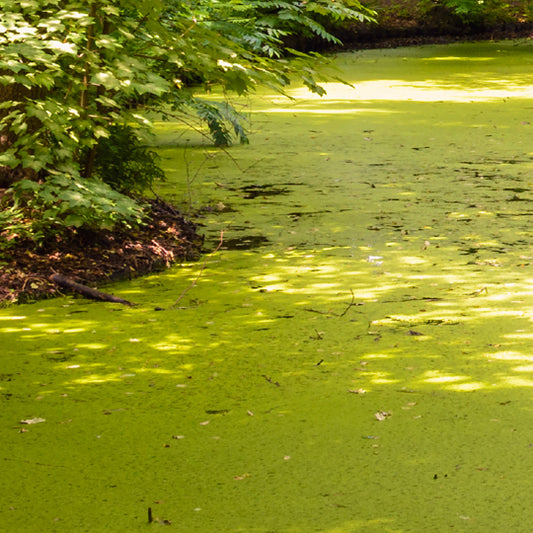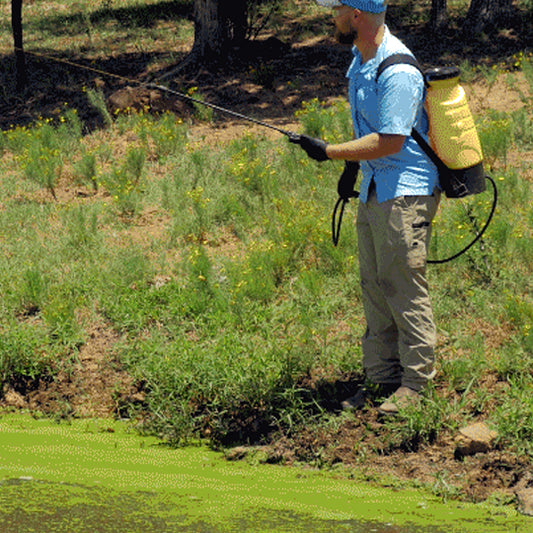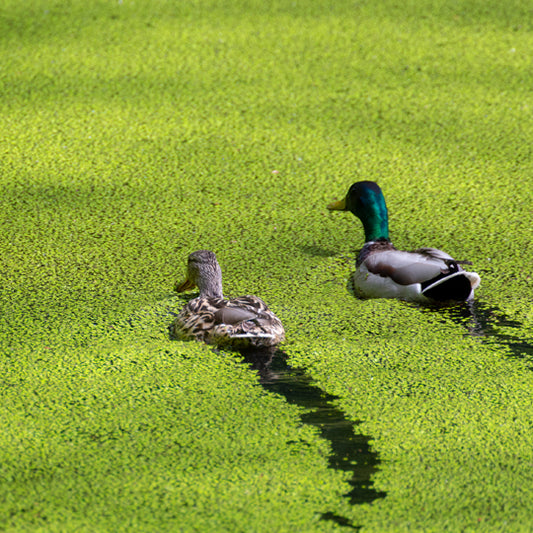Duckweed Center
-

Duckweed Basics
-

Control Duckweed
-

The Sonar Solution
-

Duckweed In-Depth
About Duckweed
Common duckweed, or Lemna minor (from the Greek lemna, “water-plant,” and minor, “lesser,”) is a very small light-green, seed-bearing aquatic perennial plant. Although it is commonly mistaken for algae, duckweed is actually one of the smallest flowering plants in the world that is often seen in thick mats covering the surface of the water. The tiny plants consist of one to three leaves, or fronds, of 1/16 to 1/8 inch in length with a single root (or root-hair) protruding from each frond. The leaves float freely on the surface of a waterbody while the root hangs below the surface to obtain nutrients from the water rather than from soil.

Common duckweed, or Lemna minor (from the Greek lemna, “water-plant,” and minor, “lesser,”) is a very small light-green, seed-bearing aquatic perennial plant. Although it is commonly mistaken for algae, duckweed is actually one of the smallest flowering plants in the world that is often seen in thick mats covering the surface of the water. The tiny plants consist of one to three leaves, or fronds, of 1/16 to 1/8 inch in length with a single root (or root-hair) protruding from each frond. The leaves float freely on the surface of a waterbody while the root hangs below the surface to obtain nutrients from the water rather than from soil.
Duckweed tends to grow in dense colonies in quiet water such as ponds, marshes, lakes and slow-moving streams. Often more than one species of duckweed will be associated together in these colonies. Lemna minor is distinguished from the other common North American duckweed, Greater Duckweed (Spirodela polyrhiza) by its single root and much smaller size. Duckweed grows in full sunlight as well as dense shade and can tolerate a wide pH range while surviving best at levels between 4.5 and 7.5. It is more cold tolerant than other aquatic vascular plants and can tolerate temperatures as low as 7° Celsius for normal growth. Under freezing conditions, duckweed will lay dormant on the pond bottom until warmer conditions return. A full, thick mat of duckweed may have a temperature of about 10° above ambient air conditions due to radiation.


Duckweed is spread from pond to pond via waterfowl or other wildlife. The plants reproduce at twice the rate of other vascular plants by seed and vegetatively throughout the growing season and spread rapidly within a waterbody, especially in those containing high levels of phosphorus and/or nitrogen. These nutrients originate from pollution, from excessive use of fertilizers or possibly by an imbalance in populations of fish or water fowl resulting in excessive nitrogenous waste products in the water. Recirculation of nitrogen and phosphorus from the cycle of growth and decomposition of the duckweed itself may also contribute to the high levels of these elements. Unlike the ordinary leaves of most plants, each duckweed frond contains buds from which more fronds may grow. These buds are hidden in pouches along the center axis of older fronds. As they grow, new fronds emerge through slits in the side of their parent fronds. Until they mature, daughter fronds may remain attached to the parent frond. Rapidly growing plants often have three or four attached fronds. In fall, budding pouches produce smaller, rootless, dark green or brownish daughter plants called turions. These dense, dormant, starch-filled structures sink in the fall and rise in the spring due to changes in starch composition and gas spaces. Other aquatic plants form turions which are distinctive terminal buds, but Lemna minor turions are very similar to ordinary fronds, just darker green and a bit smaller. Plants may overwinter as turions or as seeds, sinking and resting at the bottom of the pond until they germinate.
A small pond can quickly become infested with duckweed within just a few weeks. A duckweed colony that completely covers a pond’s surface can lead to oxygen depletion and fish kills while blocking sunlight penetration and eliminating native submerged plants. Prevention is the key to avoiding costly control measures to eliminate a nuisance duckweed problem. Nutrient reduction and getting some motion in the water through a technique such as bubble aeration are two key preventative techniques. Wind and wave action can impede duckweed growth and stabilization by disrupting the plants’ ability to attach themselves to each other and form their characteristic colonies. If duckweed does manage to take root in your pond, it is much easier to control the tiny emerging plants than the mature plants; so the best time to take action is at the first sign of infestation.
Since most pond owners consider duckweed to be a nuisance that deserves nothing short of total eradication, it may be surprising to learn that scientists, farmers, wastewater treatment experts and pharmaceutical engineers find duckweed extremely useful. Researchers are using duckweed to study basic plant development, plant biochemistry, photosynthesis, the toxicity of hazardous substances and much more. Genetic engineers are cloning duckweed genes and modifying duckweeds to inexpensively produce pharmaceuticals. Environmental scientists are using duckweeds to remove unwanted substances from water. Aquaculturalists find them an inexpensive feed source for fish farming while farmers use harvested duckweed as an animal feed. Of course, while duckweed may have its place in the laboratory or in the feeding trough, it doesn’t belong in your small




